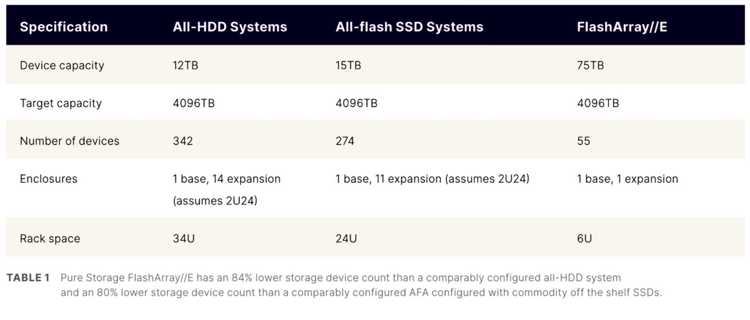Data Center of Future Is All-Flash: Will Last HDD Seller Please Turn Out Lights?
By 2028, practically no new HDD systems will be sold for enterprise data center computing for Pure Storage.
This is a Press Release edited by StorageNewsletter.com on November 1, 2023 at 2:01 pm By Michael Leworthy, marketing team, FlashArray business unit, Pure Storage, Inc.
By Michael Leworthy, marketing team, FlashArray business unit, Pure Storage, Inc.
By 2028, practically no new HDD storage systems will be sold for enterprise data center computing. That’s the prediction made by Pure in a new white paper, The All-flash Data Center Is Imminent, which shows a clear and consistent decline in HDD shipments since their high more than a decade ago.
As of 2019, up to 80% of primary storage workloads were handled by AFAs, emphasizing the importance of high-performance storage solutions. Meanwhile, HDDs were largely relegated to secondary workloads, where factors like capacity and cost took precedence over speed. Despite this shift, HDDs still accounted for approximately 90% of the total stored enterprise data, underscoring their significant presence in the storage landscape.
Click to enlarge
In the era of AI, data usage is skyrocketing at an unprecedented rate, with its appetite for data showing no signs of slowing down. However, amid the demand for even more capacity, crucial considerations of efficiency and sustainability are now coming to the forefront. Once the king of capacity, the limitations of HDD in these areas are now becoming glaringly apparent as it struggles to meet the escalating demands placed upon it.
Data center capacity: direct and to the point
It’s a different story for flash. Or more specifically, DirectFlash technology from Pure Storage, rather than commodity off-the-shelf SSDs.
With the introduction of QLC NAND and DirectFlash technology from the company, flash can now replace HDDs for capacity – and price-sensitive workloads at costs comparable to all-HDD systems (or even lower for larger systems). For the same capacity, Pure systems are far denser (smaller) and more efficient than those built around both HDDs and SSDs.
In fact, the firm’s DirectFlash Modules (DFMs) have up to 6x larger capacities than the HDDs that would actually be deployed by enterprises in a production system, at the same comparable cost. They’re up to 10x more efficient in terms of energy and power consumption and have up to 20x more reliability.
By migrating to flash, especially DFMs, you save labor, rack space, and power usage – which translates to financial savings and better scalability – as well as better sustainability.
Click to enlarge
Knock-on effects of size vs. capacity
Let’s take a quick look at some of the factors that directly affect system sizing and the impact it can have long-term (which you can also find in depth in our new white paper). A simple example is a side-by-side comparison using the same capacity (4,096TB). Taking HDD first with a 12TB HDD size (which is standard across many enterprises), you would need 6x more physical drives than the comparable Pure DFM system (75TB).
Now consider that during normal RW operations, a single 75TB DFM draws roughly 10W, while those 6x12TB HDDs will be drawing roughly 60W (6×10.1W). Add on the supporting infrastructure for those additional HDDs too – more controllers, more fans, more cables, more maintenance, more storage infrastructure, more complexity, more rack and floor space – which of course also all cost more to buy and run, and HDDs just don’t carry their weight.
Storage managers know that it is effective capacity, rather than raw capacity, that determines how much data can be stored. Disk vendors typically recommend not filling their devices more than 60%-80% full, because to do more can put both performance and data integrity at risk. And with off-the-shelf SSDs, which were designed to mimic HDDs, you are subject to similar constraints. Meanwhile, in a DFM and its marriage of hardware and software to directly manage the media, no such constraints exist – making the most of your effective capacity, space, and energy.
Is same cost as HDD, and better than SSD, really true?
Efficiency is the cornerstone of cost management, considering that the TCO of a system encompasses not only the initial purchase price but also the continuous expenses related to maintenance and support. Historically, HDDs might have been the economical option for high-capacity workloads. However, the decline in NAND costs, coupled with access to advanced flash capabilities and reductions in operational efforts, has substantially lowered both initial acquisition and ongoing management expenses.
Simultaneously, companies such as Pure are developing specialized solutions to optimize high-capacity applications previously dominated by HDD technology, such as data repositories. Take, for instance, the Pure//E Family. This solution boasts 84% fewer storage devices than its all-HDD counterpart and 80% fewer than an equivalent AFA utilizing commodity off-the-shelf SSDs (COTS SSDs) for the same capacity. It exemplifies the trend of storage modernization in the industry to reduce the overall costs of HDD and COTS SSDs while exceeding capacity and overall storage needs.
The comparisons above are based on the 75TB DFMs currently shipped by Pure. The firm’s DFMs are already up to 10x more efficient in terms of energy and floor space consumption than HDDs today. But by the end of 2024, the company will be shipping 150TB DFMs, and 300TB by 2026. This massive density difference, together with the benefits of the Purity OS, shows clear advantages of DFMs over both HDDs and COTS SSDs. An all-flash data center is simply the logical step for any enterprise coming up on a technology refresh.
(¹) Statista, 2023















 Subscribe to our free daily newsletter
Subscribe to our free daily newsletter

